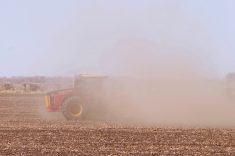Although Genny Silvernagle and her husband, Ron, consider themselves retired now, they still help their son, Brent, on the family farm and are active in their farming community near Biggar, Sask. Genny and Ron started farming together at Silver Acres farm in 1963, the same year they were married. They’ve been through a few drought years.
Genny particularly remembers the drought in 2001, which she says was different to the one currently causing considerable challenges for crop and livestock producers across Western Canada and the United States.
“It (the drought in 2001) wasn’t good, but it didn’t last this long and the temperatures didn’t seem to be this severe. We haven’t had a drop of rain through the whole month of July (this year),” she said during a telephone conversation on August 9.
Read Also

Health hazards are often overlooked risks on the farm
While quite different from the dangers posed by farm machinery, hazards such as loud noise or sun exposure require the same proactive attention, the Canadian Agricultural Safety Association says.
On the farm, the barley crop has already been written off as well as some of the wheat crop. As for canola, on about 100 acres there was no crop at all. However, the Silvernagles have been able to help out some cattle producers. A neighbour with a cattle operation cut and baled the barley crop for feed. Ron and Brent swathed the wheat crop for another farmer who also baled it for cattle feed. And the canola was tested to determine if it could be fed to cattle — that farmer was told he could mix it with other feed, so that was baled as well.
Farmers have faced many challenges this year — extreme heat, what’s shaping up to be an historic drought, wind, hail, fire, grasshoppers and the continuation of a global pandemic, to name a few. For grain farmers, the effects of the drought across the Prairie provinces have ranged from harvestable crops with lower yields to complete crop failure. At the time of writing on August 10, pasture conditions are continuing to deteriorate, hay yields are low and livestock producers are desperately trying to secure feed for cattle in Western Canada. Many farmers are feeling powerless in the face of this drought.
Dale Fossay, who has been farming in the Starbuck, Man., area for more than 40 years, says the drought has affected all of the farmers he knows in the area. On his farm, which is situated in Manitoba’s Red River Valley, Fossay has harvested a couple of fields of barley and a wheat field. The yields so far have been half of what he would normally expect.
One of Dale’s brothers farms in Manitoba’s hard-hit Interlake region, where, as of August 3, only five per cent of the area’s spring wheat, barley, oats and canola are rated good to excellent. Like the Silvernagles, who have come to the aid of their livestock producer neighbours, Dale is helping his brother out with as much straw as he can spare and with some of his oat crop (which was written off) for cattle feed.
Both the Silvernagles and the Fossays feel enrolling in crop insurance and the Canadian Agricultural Partnership business risk management programs, such as AgriInvest and AgriStability, are an important part of their risk management strategies. Dale says another way he and his brothers have weathered past droughts and financially tough decades like the ’80s (high interest rates, a few poor crops in row and low commodity prices) is to resist the temptation to buy new equipment and machinery and opt for used instead.
The Fossays also believe increasing diversity on their farms to include higher value crops suited to their regions helps spread financial risk. For example, they have chosen corn and sunflowers to help them manage risk. “Both crops have been good for me and my farming brothers,” says Dale.
Janine Sekulic, BMO’s national director of agriculture and agribusiness, in her Western Producer opinion piece “How to manage this cruel summer” from the August 5, 2021 issue, offers tips on informing and strengthening your financial positions.
From updating your financial planning tools with current information, to the importance and uses of business plans and seeking out advisors as potential resources, to tools such as cash-flow projections and break-even analysis, Sekulic discusses ways to help farmers “ensure stability in an operation, wrangle control of what can be controlled, and optimize profitability.”
Features like this one and more to help you manage the financial, emotional and crop production sides of this drought can be found on our website at grainews.ca and those of our sister publications Country Guide, The Western Producer, Alberta Farmer Express, Farmtario, Manitoba Co-operator and Canadian Cattlemen.
However, there is an easier route to access all of the information you need to manage through the 2021 drought. The Dry Times will be a resource guide available online from any point across the Glacier FarmMedia (GFM) network. You will be able to access all stories on the drought from the GFM family of publications as well as links to government and industry resources that support farm families through difficult times. This one-stop shop is accessible at farmmedia.com/dry-times and includes the categories livestock, crops and health.
The livestock category will offer the latest news, features and links to extension materials to help answer the hard questions — whether to sell or not sell, managing alternative sources of feed, balancing herd nutrition and maintaining herd health.
The crops category will also provide news, features and links to extension supports for field and crop management through these dry times. And the health category will provide information and topical links that support the farm’s most important asset — you, the farmer.
Looking after yourself and your family is even more crucial during times like these. There are many programs on offer from organizations like the Do More Agriculture Foundation to help farmers manage drought-related emotional and financial stress. There is also your own support network you’ve built up for years — your neighbours, family and friends — to connect with and who may be able to help you meet the challenges you are facing now or those that may develop in the future due to the drought.
If there is a particular resource helping you and your farm operation during this time you would like to share with other farmers, please email me at [email protected] or call me at 204-801-1645.
My thoughts are with you and I wish you a happy and safe August,
Kari
















